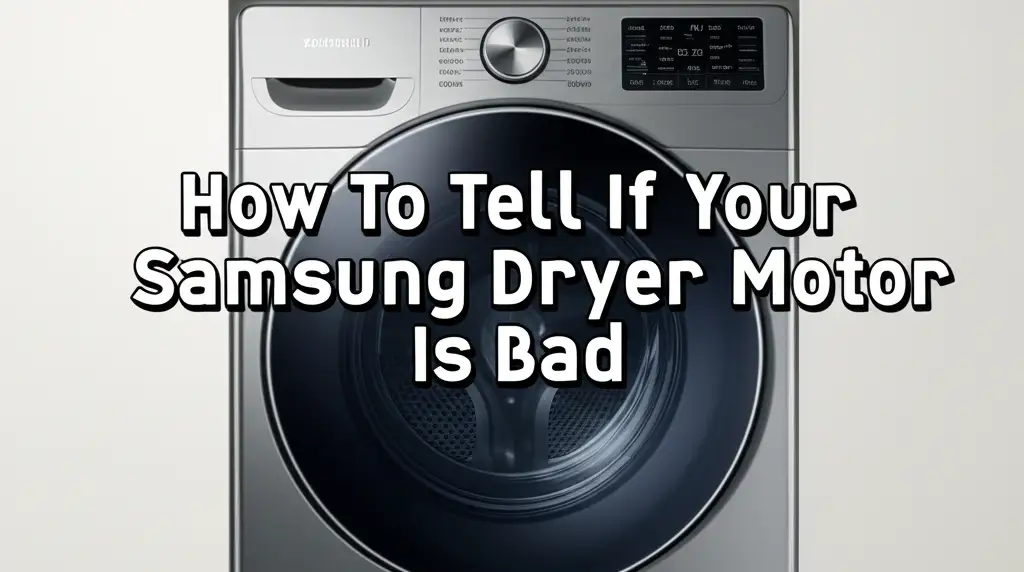· Todd Martin · Home Improvement · 19 min read
How To Reset Samsung Washing Machine To Factory Settings

Reset Your Samsung Washing Machine to Factory Settings
Have you ever faced a puzzling problem with your Samsung washing machine? Maybe it stops mid-cycle, displays a strange error code, or simply does not respond. These issues can be frustrating. My own Samsung washer sometimes acts up, leaving me wondering what went wrong. Often, a simple reset can resolve these glitches. It is like rebooting your computer when it misbehaves. This guide will show you how to reset your Samsung washing machine to factory settings. We will cover basic power cycles, specific button combinations, and calibration steps. Understanding these methods helps your machine run smoothly again.
Takeaway
Resetting your Samsung washing machine can fix many common issues.
- Always disconnect power first for safety.
- Basic power cycles solve minor glitches.
- Specific button combinations perform a hard reset.
- Calibration is important after certain resets.
- Proper maintenance prevents future problems.
To reset a Samsung washing machine to factory settings, first unplug it for a few minutes. This performs a basic power cycle. For a hard reset, specific models may require holding down certain buttons like “Power” and “Start/Pause” simultaneously for several seconds until the display clears. Always refer to your model’s user manual for precise instructions.
Why Reset Your Samsung Washing Machine: Common Problems Solved
Your Samsung washing machine is a complex appliance. It uses many sensors and programs to clean clothes. Sometimes, these systems can experience glitches. A reset helps clear these temporary errors. Think of it as giving your machine a fresh start. It can resolve many common operational problems.
One frequent issue is the machine freezing or becoming unresponsive. You press buttons, but nothing happens. This often points to a software lock-up. An error code might appear on the display. These codes indicate specific problems, but sometimes they are false alarms. A reset can clear these codes. It allows the machine’s internal computer to reboot. This often restores normal function.
Another problem might be the wash cycle stopping unexpectedly. The machine might pause and refuse to continue. Or perhaps it drains improperly. I experienced this once, and my clothes were left soaking wet. A factory reset can re-establish the default program settings. This helps the machine execute cycles correctly again. It effectively removes any corrupted temporary data.
Sometimes, a Samsung washing machine might struggle with balancing loads. This leads to excessive vibration and noise during the spin cycle. While physical leveling is important, an internal calibration issue can also be a cause. Resetting often includes a recalibration process. This helps the machine correctly sense the load. It ensures a stable and efficient wash. If your machine is vibrating excessively, a reset might be the first step.
Finally, user programming errors can occur. You might accidentally change a setting or create a custom cycle that does not work. A factory reset returns all settings to their original state. This removes any user-defined programs or preferences. It ensures the machine operates as it did out of the box. This can be very useful if you have forgotten how to revert a specific setting. It gives you a clean slate.
Essential Preparations Before Resetting Your Samsung Washer
Before you reset your Samsung washing machine, a few crucial steps are necessary. These steps ensure your safety and help the reset process go smoothly. Skipping these preparations can lead to further issues or even personal injury. It is always better to be safe.
First, identify your Samsung washing machine model number. This is usually on a sticker inside the door, on the back, or sometimes on the control panel. Knowing your model helps locate specific instructions. Samsung makes many washing machine models, and reset procedures can vary. Your user manual is the best source for precise steps. If you do not have a physical copy, you can usually find it online using your model number.
Next, ensure the machine is empty. Remove all clothes from the drum. Also, check that no water remains inside. If there is water, you may need to drain it manually. This ensures a safe environment for the reset. Running a drain and spin cycle before starting might be helpful. This prepares the machine for the process. If you need to drain water manually, consult a specific guide.
Safety is paramount. Always disconnect the power to your washing machine before attempting any reset or troubleshooting. Unplug the machine from the wall outlet. If reaching the outlet is difficult, turn off the corresponding circuit breaker at your home’s electrical panel. This prevents accidental shocks. It also ensures the machine fully de-energizes. My appliance technician always stresses this rule. Never work on an appliance that is still plugged in.
Consider the potential loss of custom settings. A factory reset will erase any specific wash cycles you have programmed. It also removes any preferred temperature or spin settings you might have saved. If these settings are important to you, write them down. This way, you can easily re-enter them after the reset. Most users do not have many custom settings, but it is good to be aware.
Finally, be ready to monitor the machine after the reset. Some resets initiate a calibration cycle. Others might just clear codes. Having the manual handy helps you understand what to expect. This preparation ensures you are ready for the next steps. It sets the stage for a successful reset operation.
How to Perform a Basic Power Cycle Reset on Samsung Washers
A basic power cycle is often the simplest and first troubleshooting step. It is like rebooting your computer. This method can clear minor software glitches or temporary errors. It is very easy to do and requires no special tools or technical skills. I always try this first when my washing machine acts strangely.
Start by ensuring your Samsung washing machine is not currently running a cycle. If it is mid-cycle, pause it if possible. Then, turn the machine off using its power button on the control panel. This prepares the machine for a complete shutdown. Do not just rely on turning it off from the control panel.
The next step is crucial: unplug the washing machine from the power outlet. Make sure the plug is completely removed from the wall. This cuts off all electrical supply to the machine. If you cannot reach the plug, go to your home’s circuit breaker box. Find the breaker labeled for your laundry room or washing machine. Flip it to the “off” position. This achieves the same power cutoff.
Once the power is disconnected, wait for a specific period. A minimum of 5 to 10 minutes is usually recommended. Some experts suggest waiting even longer, up to 30 minutes, for a full drain of residual power. This waiting period allows the machine’s internal capacitors to discharge completely. It helps clear any lingering electrical charges or memory errors. This is the “reset” part of the power cycle.
After the waiting period, plug the washing machine back into the power outlet. If you used the circuit breaker, flip it back to the “on” position. The machine should power on or be ready to power on. You might hear a beep or see the display light up. This indicates that power has been restored.
Finally, try to use your washing machine as normal. Select a wash cycle and press start. Observe if the previous issue has been resolved. For many common problems, this basic power cycle is enough to fix them. It is a fundamental troubleshooting step for many home appliances. It costs nothing and often saves a service call. This simple step can restore your appliance to proper working order.
Advanced Hard Reset Methods for Samsung Washing Machines
When a basic power cycle does not work, an advanced hard reset might be necessary. This process goes deeper. It forces the machine’s control board to clear its memory more thoroughly. These methods often involve specific button combinations. The exact steps can vary significantly by Samsung washing machine model. Always refer to your specific model’s user manual for precise instructions.
For many Samsung washing machines, a common hard reset method involves holding down certain control panel buttons. First, ensure the machine is powered off but still plugged in. Then, press and hold the “Spin” and “Temp” buttons simultaneously for about 5-8 seconds. The display might show “888” or clear completely. This indicates the reset has initiated. Release the buttons once this occurs. Some models might require holding “Temp” and “Delay End” or other combinations. My older Samsung model used “Spin” and “Rinse” for a hard reset.
Another common advanced reset is accessing a “diagnostic mode” or “service mode.” This is not a factory reset in the traditional sense. However, it often includes options to clear errors or reset the machine. To enter this mode, you might need to press specific buttons like “Delay Start” and “Child Lock” together. Or, for some models, it is “Wash” and “Rinse” while simultaneously turning the cycle selector knob. The display will then show a code or menu. Be careful in this mode, as incorrect inputs can cause new issues. Only proceed if you have your manual open.
Some Samsung washing machines, particularly newer or more advanced models, might not have a simple button combination for a “factory reset” per se. Instead, they rely on power cycling or automatically clearing errors. For these models, clearing specific error codes might be the closest thing to a reset. If your machine displays an error, like a locked door error, clearing the error often resolves it.
If these button combinations do not work, try a long power disconnection. Unplug the machine for an extended period, such as an hour or even overnight. This gives the control board ample time to fully discharge. This “extended power cycle” acts as a deeper reset for some stubborn issues. It can sometimes resolve problems that a quick unplugging cannot. Always re-check your user manual if you are unsure. This ensures you use the correct method for your specific model.
Addressing Error Codes: When a Samsung Washing Machine Reset Helps
Samsung washing machines use error codes to communicate problems. These codes appear on the digital display. They indicate specific issues, from simple sensor malfunctions to more serious component failures. Sometimes, a reset can clear these codes. It can help determine if the problem is a temporary glitch or a persistent fault.
Common error codes include “4C” (water supply issue), “5C” (drainage problem), or “dC” (door open/unlocked). When such a code appears, the machine usually stops working. It will not allow you to start a new cycle. My washer once showed a “4C” code. I checked the water hoses, found no issues, and performed a reset. The code cleared, and it worked fine. This indicated a temporary sensor misread.
Before attempting a reset, identify the error code. Look up its meaning in your Samsung washing machine’s user manual. Understanding the code helps you troubleshoot effectively. Sometimes, the issue is physical, not electronic. For example, a “5C” code might mean your drain pump filter is clogged. In this case, cleaning the filter is the real solution, not just a reset. A reset might temporarily clear the code, but it will return if the underlying problem persists.
If the error code indicates a software glitch or sensor error, a reset is a good first step. Performing a basic power cycle often clears these codes. The machine’s control board reboots and re-checks its systems. If the sensor was just temporarily misreading, the code will disappear. If the code reappears immediately after a reset, it points to a more serious hardware issue. This means the component itself might be faulty.
Some error codes might specifically recommend a reset or calibration. For example, codes related to unbalance detection might require recalibration after a load. A hard reset can sometimes initiate this calibration. Always follow the manufacturer’s guidance in your manual for specific error codes. Do not ignore persistent codes. While a reset can offer a quick fix, it is not a cure-all for all problems. It is a diagnostic tool.
If an error code returns after multiple reset attempts, professional service is likely needed. This indicates a genuine fault in a component. It could be a faulty water valve, a bad drain pump, or a damaged control board. A reset cannot fix broken parts. It only resets the software. Therefore, use the reset as a first line of defense against electronic glitches.
Calibrating Your Samsung Washing Machine Post-Reset
After you reset your Samsung washing machine, especially a hard reset, calibration is often a critical next step. Calibration helps the washing machine learn the weight and balance of loads. It ensures stable and efficient operation. Skipping this step can lead to issues like excessive vibration during spin cycles or inaccurate water levels. My washer always spins better after a calibration.
The calibration process helps the machine optimize its performance. It “learns” how much the drum weighs when empty. Then, it uses this information to detect imbalances during a wash cycle. This is especially important for front-load and high-efficiency top-load washers. Without proper calibration, the machine might struggle to properly distribute the clothes. This causes banging or vibrating, especially during high-speed spinning. If your machine is already banging during spinning, recalibration can sometimes help.
To calibrate your Samsung washing machine, the exact steps vary by model. However, a common procedure involves an empty drum. Ensure no clothes are inside. Close the washer door. Then, press and hold specific buttons, often “Spin” and “Rinse,” or “Temp” and “Delay End,” for a few seconds. The display might show “Cb” or “CAL” to indicate calibration mode. Release the buttons once this appears.
The machine will then begin a calibration cycle. This cycle is typically short, lasting only a few minutes. The drum will rotate slowly in both directions. It may stop and start multiple times. This is normal. The machine is measuring the weight of the empty drum. It is also adjusting its internal sensors. Do not open the door or interrupt the cycle once it begins. Let it complete fully.
Once the calibration cycle finishes, the display will usually show “0” or turn off. This confirms the calibration is complete. Your washing machine is now ready to use. It should operate with improved stability and efficiency. If your machine still vibrates excessively after calibration and proper leveling, then other issues might be present. This could include worn shock absorbers or a faulty motor.
Always refer to your Samsung washing machine’s user manual for the precise calibration steps. It is the most reliable source for your specific model. Proper calibration ensures the machine functions as designed. It helps prevent common operational problems and extends the life of your appliance. It is a small step with big benefits for your laundry experience.
Beyond the Reset: Maintaining Your Samsung Washer for Longevity
Resetting your Samsung washing machine can fix immediate problems. However, regular maintenance is key to preventing future issues and ensuring longevity. A well-maintained washing machine runs more efficiently. It also needs fewer repairs over its lifespan. I learned this the hard way with my first washer.
One of the most important maintenance tasks is cleaning the washing machine. Over time, detergent residue, fabric softener, and lint can build up. This creates a prime environment for mold and mildew. These can cause unpleasant odors and affect machine performance. For Samsung washing machines, especially front-loaders, cleaning the drum and detergent dispenser is vital. Running a “Self Clean” cycle monthly is highly recommended. If your machine does not have this feature, you can run a hot water cycle with vinegar or bleach. You can find detailed instructions on how to clean your Samsung washing machine for a thorough cleaning.
Do not forget the filter. Many washing machines have a drain pump filter that catches small items and lint. This filter can become clogged, leading to drainage issues. A clogged filter can even trigger error codes like “5C.” Regularly check and clean this filter. For front-loaders, it is usually behind a small door at the bottom front of the machine. For top-loaders, the filter might be located elsewhere, so check your manual for how to clean your top loader filter. This simple task can prevent many headaches.
Another maintenance tip is to use the correct amount of detergent. Using too much detergent, especially in high-efficiency (HE) machines, creates excessive suds. This can confuse the machine’s sensors. It can also lead to residue buildup. Always use HE detergent for HE washers. Follow the detergent manufacturer’s recommendations for load size. This helps maintain the internal components.
Check the hoses periodically. Inspect the inlet hoses for cracks or leaks. Ensure the connections are tight. A loose connection can cause leaks from the bottom of your machine. Also, ensure the drain hose is not kinked or obstructed. Proper hose maintenance prevents water supply and drainage problems. These issues can often lead to error codes that might prompt a reset.
Finally, keep the washing machine level. An unbalanced machine puts extra strain on internal components. It causes excessive vibration and noise. Use a level tool to check that all four feet are firmly on the floor. Adjust the leveling feet as needed. Proper leveling also aids in even load distribution during cycles. Regular maintenance keeps your Samsung washing machine performing at its best.
When Resetting Fails: Seeking Professional Samsung Appliance Help
While resetting your Samsung washing machine can solve many common problems, it is not a magic bullet. Some issues are beyond the scope of a simple reset. These indicate deeper hardware failures or complex electronic faults. Knowing when to call a professional is important. It prevents further damage and ensures a proper repair. My general rule is, if two resets do not fix it, I call for help.
If your Samsung washing machine continues to display the same error code after multiple resets, it is a clear sign. This indicates a persistent problem with a specific component. For example, if a “5C” error persists after cleaning the filter and resetting, the drain pump itself might be faulty. A reset cannot repair a broken pump motor or a cracked hose. These require physical repair or replacement.
Strange noises that do not disappear after a reset also point to mechanical issues. Grinding, squealing, or loud banging during a cycle suggests worn-out bearings, a faulty motor, or issues with the suspension system. A reset only affects the machine’s software and electrical state. It does not lubricate parts or replace worn components. These problems need a technician’s inspection.
Physical damage or leaks are also beyond a reset’s capability. If you see water leaking from the machine, it is a plumbing or structural issue. This could be a loose hose, a cracked tub, or a seal failure. A reset will not seal a leak. It is essential to turn off the water supply immediately and call for service. Continuing to use a leaking machine can cause water damage to your home.
Intermittent problems that return randomly might also need a professional. Sometimes a reset provides a temporary fix, but the issue keeps coming back. This could indicate a failing control board or a loose electrical connection. These types of problems are hard to diagnose without specialized tools and expertise. A professional can run diagnostic tests to pinpoint the exact cause.
Finally, if you are uncomfortable performing any troubleshooting steps yourself, or if you suspect a complex electrical issue, always call a certified technician. Working with electricity and heavy appliances can be dangerous. Professionals have the training and tools to safely diagnose and repair your Samsung washing machine. They can accurately identify the problem and provide a lasting solution. Do not hesitate to seek help when needed.
FAQ Section
Q1: How often should I reset my Samsung washing machine? A1: You should only reset your Samsung washing machine when it experiences a problem. There is no need for regular, routine resets. Think of it as a troubleshooting step, not a maintenance schedule. If your machine is working perfectly, leave it be. Frequent unexplained resets might indicate a recurring underlying issue.
Q2: Will a factory reset erase all my saved settings and cycles? A2: Yes, a factory reset typically erases any custom wash cycles or preferred settings you have programmed into the machine. It returns the machine to its default, out-of-the-box state. A basic power cycle, however, usually does not erase saved settings. Always note down any important custom settings before a hard reset.
Q3: What is the difference between a power cycle and a factory reset? A3: A power cycle is a simple disconnection from power for a short period (5-10 minutes) to clear minor glitches. A factory reset, often involving specific button combinations, is a deeper reset that wipes internal memory and restores default settings. A power cycle is often the first step, while a factory reset is for more stubborn issues.
Q4: Can resetting my washing machine fix major mechanical issues? A4: No, resetting your washing machine cannot fix major mechanical issues. It only addresses software glitches, temporary errors, or calibration problems. A reset will not repair broken parts like a faulty motor, worn bearings, a leaking hose, or a clogged drain pump. Mechanical problems require professional repair or part replacement.
Q5: Is it safe to reset my Samsung washing machine myself? A5: Yes, performing a basic power cycle or a button combination reset is generally safe if you follow instructions carefully. Always unplug the machine from power before touching any internal components. If you are unsure or uncomfortable, or if the issue persists, it is always safer to call a qualified appliance technician.
Q6: What should I do if my washing machine still has problems after a reset? A6: If your Samsung washing machine continues to have problems after a reset, it likely indicates a more serious underlying issue. Check your user manual for specific error code troubleshooting. If the problem persists, or if you suspect a hardware failure, it is best to contact Samsung customer support or schedule service with a certified appliance technician.
Conclusion
Resetting your Samsung washing machine to factory settings is a powerful tool. It can resolve many common issues, from error codes to unresponsive controls. We have covered the simple power cycle, which often fixes minor glitches. We also explored advanced hard reset methods for more stubborn problems. Remember that calibration after a reset is often important. It helps your machine operate smoothly.
I hope this guide gives you the confidence to troubleshoot your Samsung washer. Always prioritize safety by unplugging the machine. Refer to your specific model’s manual for precise instructions. While a reset can fix many electronic hiccups, it is not a cure for mechanical failures. Regular maintenance also helps prevent issues. This includes cleaning the machine and its filters. Knowing when to call a professional is also key. Your Samsung washing machine is a valuable appliance. Keeping it in top shape ensures fresh, clean laundry for years to come.





